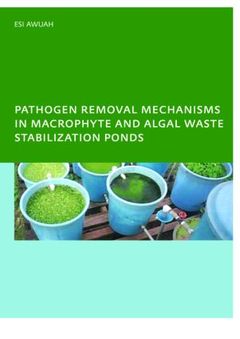Pathogen Removal Mechanisms in Macrophyte and Algal Waste Stabilization Ponds PhD: UNESCO-IHE Institute, Delft
Auteur : Awuah E.

Pathogen removal mechanisms in macrophyte and algal-based waste stabilization ponds were studied in Ghana and Colombia. The macrophytes used were water lettuce (Pistia stratiotes) and duckweeds (Lemna paucicostata and Spirodela polyrhiza). The selection of the species was based on economic importance and availability. Lemna was used during the initial investigations. However, Lemna could not withstand the ammonia levels in the wastewater used. Spirodela polyrhiza a rarer species in Ghana was therefore used in subsequent studies. The main mechanisms considered in this study were pH, protozoa predation and surface attachment. The microorganisms used were faecal bacteria namely; Escherichia coli, other coliforms, Salmonella sp., other enterobacteria, E. coli, ATCC13706 and enterococci. Studies were conducted using batch scale, continuous flow bench and pilot scale ponds. Results indicated in order of importance that long retention periods, attachment, sedimentation, predation and low pH are mechanisms in macrophyte ponds enhancing faecal bacteria removal, while in the algal ponds long retention periods, sunlight penetration, high pH, attachment and sedimentation are the mechanisms of importance in faecal bacteria removal. Presence of protozoa was also found to be important but true grazing studies could not be quantified. Dissolved oxygen did not play a major role in faecal bacteria removal.
1. Introduction 2. Environmental Conditions and Enterococci Removal in Macrophyte and Algal-Based Domestic Wastewater Treatment Systems 3. The Effect of pH on Enterococci Removal in Water Lettuce, Duckweed and Algal Ponds 4. Environmental Conditions and Effect of pH on Faecal Coliform Removal in Macrophyte and Algal Ponds 5. Effect of pH Fluctuations on Pathogenic Bacteria Removal in Domestic Wastewater 6. Comparative Performance studies of Macrophyte and Algal Ponds using Low Strength Sewage 7. Comparative Performance Studies of Macrophyte and Algal Ponds Using Medium Strength Sewage 8. The Role of Attachment in the Removal of Faecal Bacteria from Macrophyte and Algal Waste Stabilization 9. Effect of Protozoa on Faecal Bacteria Removal in Macrophyte and Algal Waste Stabilization Ponds Summary in English Summary in Dutch
Professor Mrs. Esi Awuah obtained her bachelor’s degree at the Kwame Nkrumah University of Science and Technology, Kumasi with a major in Microbiology.
In 1981, she received a WHO award in connection with the Water and Sanitation Decade to do her masters in Environmental Science at the College of Environmental Science and Forestry (SUNY) Syracuse, New York, USA and obtained her Master of Science in 1985.
In 1998, she obtained a fellowship from the Netherlands Government to pursue a PhD degree within the Water and Sanitation Sector Capacity building program in the Department of Civil Engineering, KNUST Kumasi, Ghana at UNESCO-IHE, Delft Netherlands.
She is currently an Associate Professor and the Head of Civil Engineering Department at the Kwame Nkrumah University of Science and Technology, Kumasi, Ghana.
She is also the Head of Department of Environment and Technology at the Institute of Science and Technology for Africa at KNUST, Kumasi and the Environmental Consultant for the Kwame Nkrumah University of Science and Technology, Kumasi, Ghana
Her research areas
- Environmental quality assessment
- Wastewater treatment/Solid waste management
- Water supply and sanitation
- Ecological city development
She is a member of the following organizations
- Third World Organization of Women in Science (TWOWS)
- Ghana Science Association
- Ghana National Association of University Teachers
Date de parution : 01-2007
21x28 cm
Date de parution : 10-2017
21x28 cm



